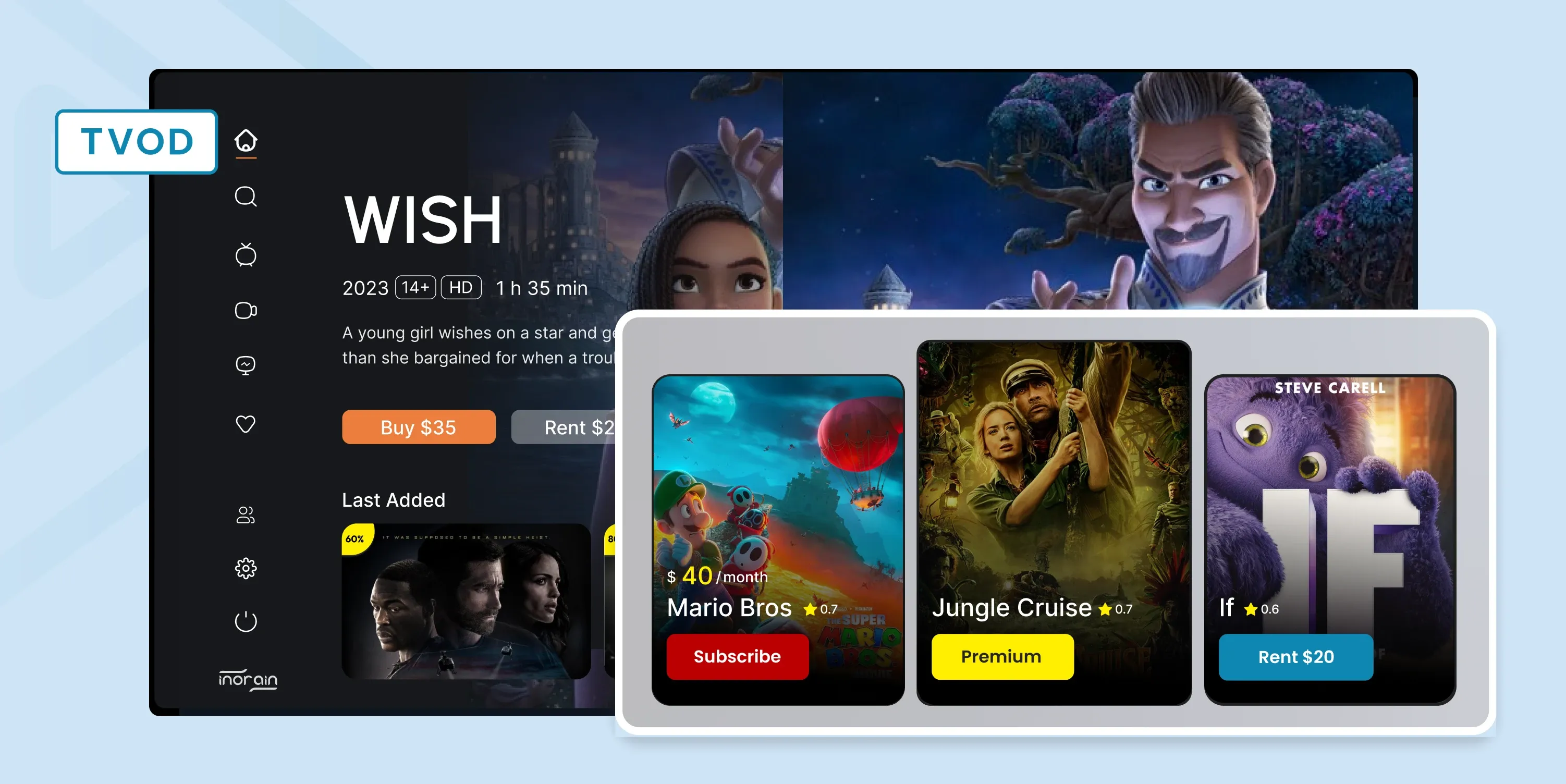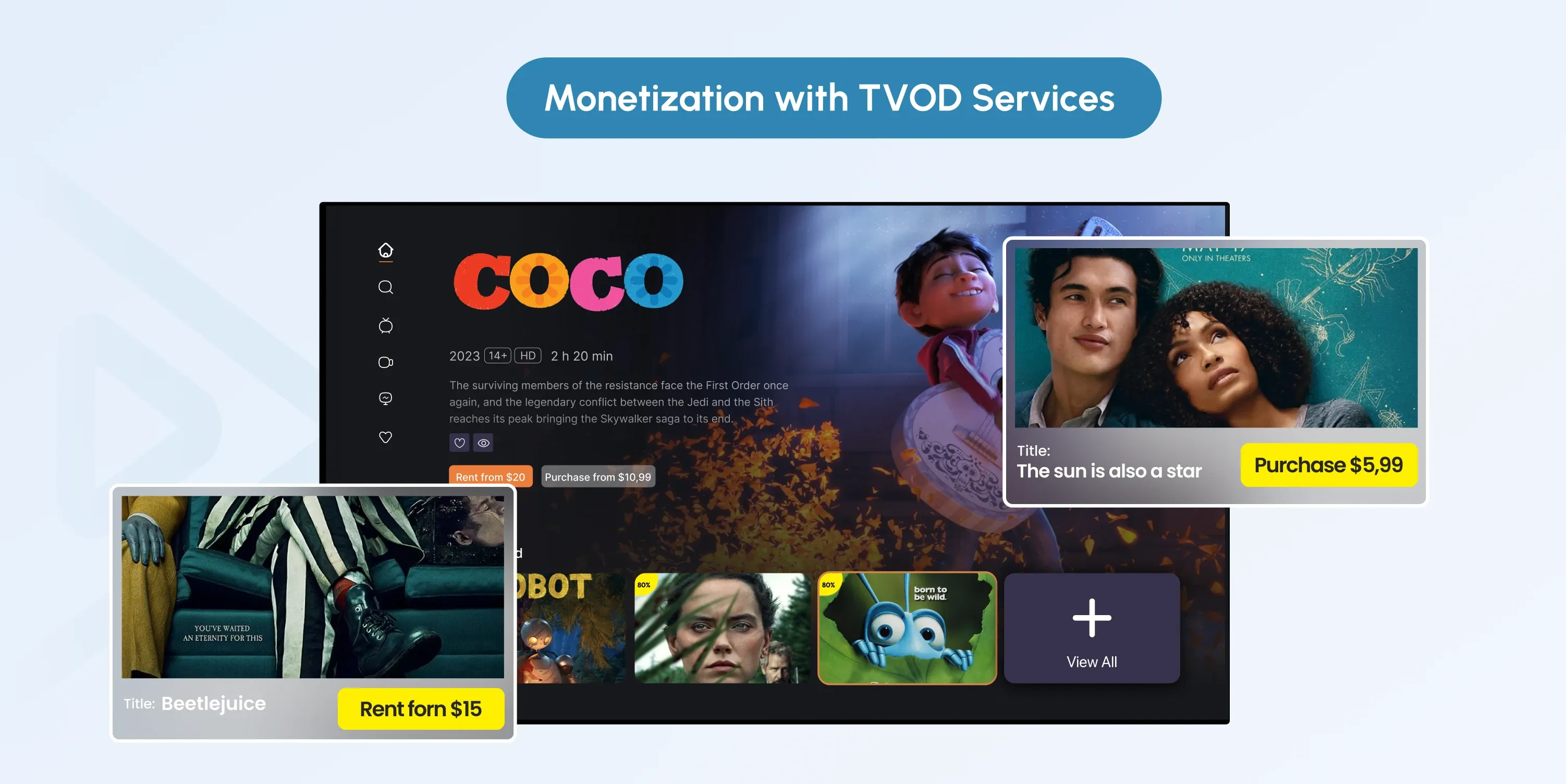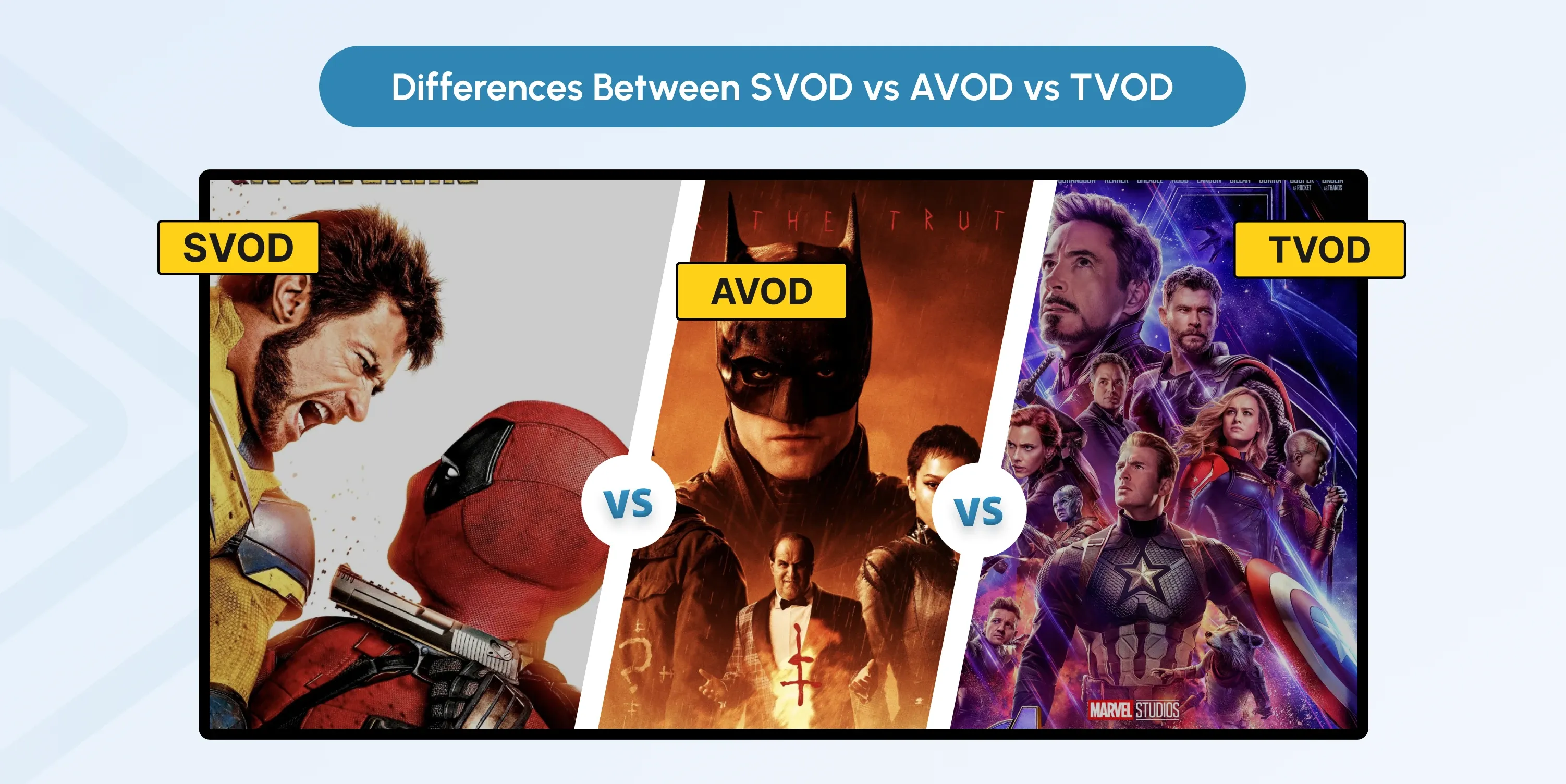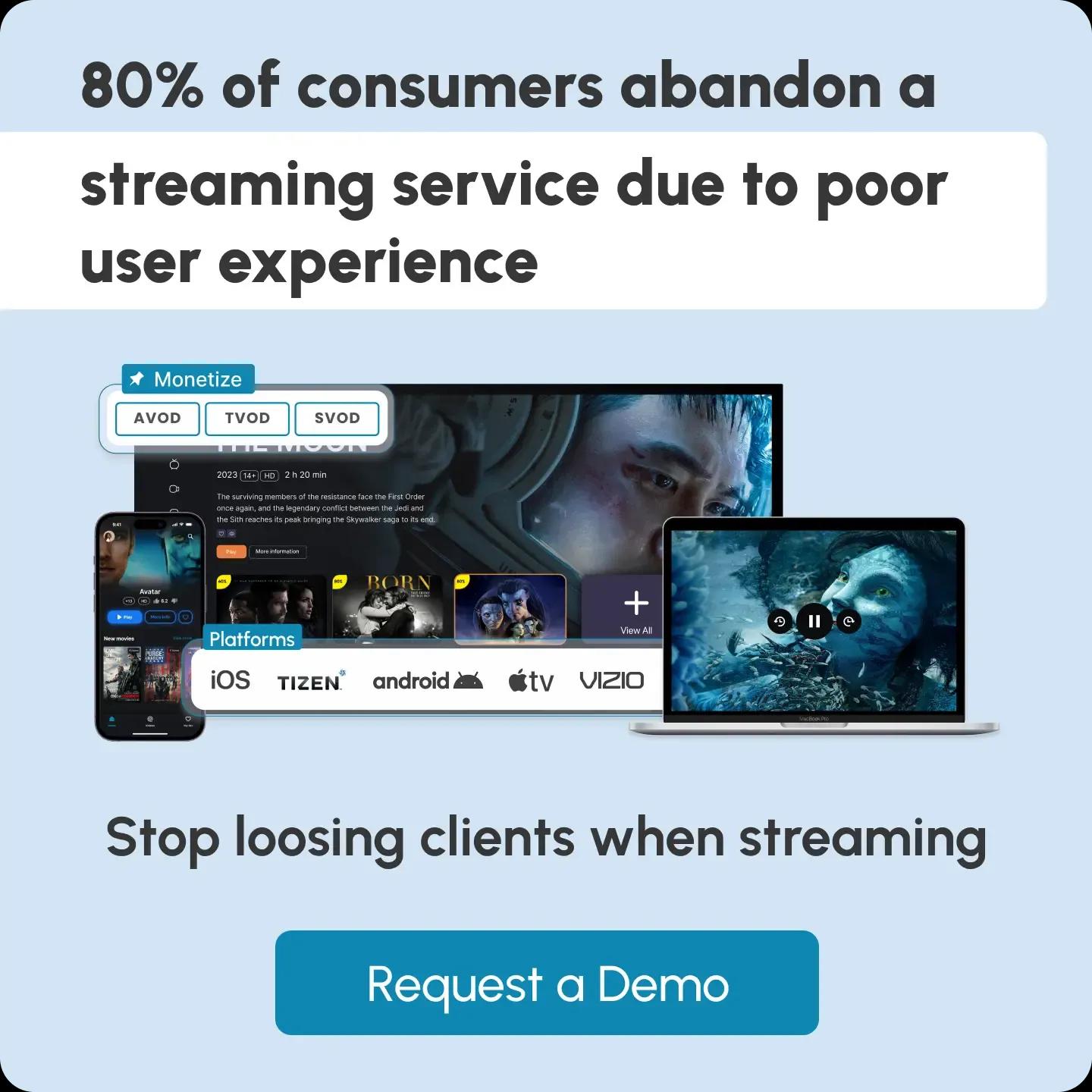
What is TVOD? Definition and Key Features
Transactional Video on Demand (TVOD) has become a popular on-demand model. But what sets TVOD apart from the rest of monetization models?
Whether you're seeking flexibility in purchasing content or new ways to monetize digital media, TVOD offers a direct, pay-as-you-go approach to offering and accessing premium video content.
In this article, we'll explain the meaning of TVOD, talk about its core features, and explore why it’s a preferred option for consumers and businesses alike.
Let's get started!

Key Takeaways
- With TVOD, your business can make money online from video content by either renting or selling it to consumers.
- TVOD platforms let consumers rent content for a limited time or purchase it for permanent access, making it adaptable to different viewing preferences and budgets.
- TVOD can help companies and content creators find new ways to earn money while giving viewers premium or exclusive content, such as new releases, live events, or niche films.
What is TVOD?
Transactional video-on-demand (TVOD) is a content monetization method for distributing movies, TV series, or live events that enables consumers to pay for a single piece of content instead of a complete library of movies or TV shows. It’s a simple, pay-as-you-go system where you only pay for what you want to watch.
Unlike the typical subscription model, where you pay a monthly fee for unlimited access, a TVOD platform charges viewers per video, offering more flexibility. Once you purchase a movie or show, you can enjoy it for a set period—perfect for those who prefer to pick and choose.
As consumer preferences evolve, more platforms are adopting TVOD, allowing content creators to cater to various budgets and needs while maximizing revenue.
Key Features of TVOD
TVOD is a flexible model that gives viewers control over their purchases. Here are the key features that make TVOD stand out:
Pay-Per-View Model
The pay-per-view (PPV) concept is a fundamental component of TVOD services. Users can pay for certain content rather than registering for a library membership.
For example, pay-per-view is used for private events like concerts or sports games for those willing to pay more for a premium viewing experience.
Rent or Buy Options
Like renting a DVD from Blockbuster, TVOD renting allows users to access content for a limited period at a more affordable price. Usually starting from the initial play, this time range runs 24 to 48 hours. It’s perfect for those who merely want to view specific content just once—for example, a newly released film.
On the other hand, the buying option gives users unrestricted access to the content, so they can download it or keep it in their TVOD platform library. Though it costs more than renting, this option is ideal for those who wish to keep their copy of the content.
Wide Range of Content
Whether you’re into major releases or more obscure content, there's always something to suit your taste. Unlike subscription services, many TVOD platforms give you access to exclusive content like live sports events, concerts, and new movies. Some of the best TVOD examples include unique media that you won’t find on subscription-based services.
Cross-Platform Availability
One of the most convenient aspects of TVOD is its flexibility across multiple devices. Whether you're using a PC, smart TV, tablet, or smartphone, TVOD platforms ensure easy access to your content.
Most TVOD services allow users to sync their accounts, making it easy to pick up where they left off, no matter the device. This means you can start a movie on your TV at home and then seamlessly continue it on your phone while on the go.
Benefits of TVOD
TVOD enhances content accessibility and revenue generation. The table below outlines the key advantages for each group.
| Beneficiary | Key Benefits of TVOD |
|---|---|
| Streaming Platform Owners | - Flexible Pricing: Set different prices for various content types to maximize revenue. - Broader Customer Base: Adjust pricing to attract and retain a wider audience. |
| Content Creators | - Reliable Income Stream: Generates predictable revenue to sustain and fund future projects. - Profitability: Provides a clearer path to financial success compared to other models. |
| Viewers | - Exclusive Content: Access new releases before they appear on SVOD platforms. - Immediate Access: Watch fresh content instantly without delays. - Event-Based Viewing: Ideal for one-time purchases like sports events, concerts, and new films. |
| Advertisers | - Targeted Ads: Ads are placed in content that users actively seek, increasing relevance. - Higher Conversion Rates: More relevant ads result in better engagement and returns. |
Monetization with TVOD Services
By charging users per purchase or rental rather than a flat subscription fee, TVOD allows companies to maximize earnings from individual content pieces, while offering viewers greater control over what they pay for.
 Below are the top three ways to earn money with the TVOD model.
Below are the top three ways to earn money with the TVOD model.
Pay-Per-View
Pay-per-view (PPV) charges viewers a one-time fee to access exclusive events or shows. PPV is ideal for monetizing live events like concerts or sports games, attracting audiences who are willing to pay for one-time access.
This model allows creators to generate significant revenue without requiring users to commit to ongoing subscriptions, making it perfect for high-demand, time-sensitive content.
Electronic Sell-Through
With electronic Sell-Through (EST), users pay a one-time fee to own specific movies or shows, giving them unlimited access without the need for a subscription or rental.
For content owners, EST creates a more predictable income flow, as users are willing to pay more for permanent ownership. It also reduces the reliance on recurring subscriptions while offering the flexibility for viewers to watch on any device at any time.
Download to Rent
Download to Rent (DTR) is a suitable option for content creators, allowing them to monetize their work by offering limited-time access. It’s a fantastic way to earn income from users who prefer short-term rentals over full purchases.
With DTR, the revenue opportunities may be more prevalent since users frequently rent content they may not want to own. This model allows creators to capture income from casual viewers who only need temporary access to their movies or shows.
Key Differences Between SVOD vs. AVOD vs. TVOD
When comparing SVOD, AVOD, and TVOD, the primary difference lies in how users pay for content. With TVOD, viewers pay per title, giving them the freedom to choose exactly what they want to spend money on.
In contrast, SVOD operates on a subscription model, where users pay a set fee—usually monthly or annually—to access a vast library of content. This offers a more predictable expense and unlimited viewing within the subscription period.
AVOD, on the other hand, provides free content but incorporates ads into the viewing experience. Users don't pay directly for the content, but advertisers cover the cost by paying to have their ads featured, leading to interruptions during the video.
 In terms of user experience, SVOD subscribers enjoy uninterrupted viewing without ads, while AVOD users have to watch ads in exchange for free access. TVOD strikes a balance by offering ad-free content, but viewers must pay for each piece of programming individually.
In terms of user experience, SVOD subscribers enjoy uninterrupted viewing without ads, while AVOD users have to watch ads in exchange for free access. TVOD strikes a balance by offering ad-free content, but viewers must pay for each piece of programming individually.
From a monetization perspective, SVOD platforms generate income through regular subscription fees, AVOD earns revenue from advertisers, and TVOD profits from individual transactions when users purchase or rent specific content.
The Role of OTT Platforms in TVOD
OTT platforms have completely revolutionized how we access content, giving consumers more freedom than ever before. They offer a range of viewing models, including TVOD (pay-per-view), SVOD (subscriptions), and AVOD (ad-supported).
For businesses or creators looking to launch their own TVOD platform, InoRain is the perfect partner.
We provide fully customizable, white-label OTT solutions that allow businesses to create their streaming service with total branding freedom—no technical expertise required.
Our platform supports more than 10 monetization models, including TVOD, SVOD, and AVOD—giving you total flexibility in how you monetize your content. Plus, with zero revenue sharing and a lifetime ownership option, you retain full control over your earnings.
Whether you're a content creator, broadcaster, or business owner, InoRain can help you launch and scale your streaming platform with ease.
Ready to get started? Request a demo today and see how InoRain turns your streaming vision into reality.
Future Trends in TVOD
The VOD and OTT sectors are set for major shifts by the end of 2024, driven by evolving viewer preferences and innovative technology. According to a Deloitte report, almost 50% of users say they would spend more time on streaming services if finding content was easier—highlighting the growing demand for personalized recommendations.
Here is what to look forward to:
- Advancements in AI and machine learning will enhance content recommendations, delivering highly personalized experiences that keep users engaged.
- Meanwhile, virtual and augmented reality are making streaming more immersive and interactive, especially for younger audiences.
- Exclusive, high-quality programming will remain essential, driving the rise of niche streaming services as platforms invest in original content.
- The adoption of 5G will further improve streaming speeds and quality, ensuring seamless high-definition viewing across devices.
- Additionally, streaming will become more social, with features like watch parties and live interactions allowing users to enjoy content together, no matter the distance.
Conclusion
TVOD is revolutionizing how viewers access media by giving them more control over what they watch and pay for. Whether you're looking to rent the latest blockbuster, buy your favorite TV series, or enjoy exclusive live events, TVOD caters to individual viewing preferences, offering flexibility in both content selection and payment.
If you’re ready to launch your own TVOD platform, then partner with InoRain today to take full advantage of its benefits.
FAQs
What does TVOD stand for?
TVOD stands for transactional video on demand. This type of service plan lets people pay for single pieces of content, like movies or TV shows, instead of subscribing to a whole library of content.
What are the popular TVOD platforms?
TVOD content is widely available across popular platforms like Apple’s iTunes, Amazon Prime Video, and Sky Sports Box Office.
Can TVOD be combined with other monetization models?
Yes! For example, inoRain offers an OTT solution with flexible hybrid models that combine TVOD with SVOD or AVOD. This means a platform may offer a subscription for general content access but charge extra for premium or exclusive content via TVOD.
What are the typical costs for renting or purchasing content on TVOD platforms?
Rental prices typically range from $3 to $6 for standard definition and $5 to $8 for HD or 4K quality. Purchase prices can vary significantly, typically falling between $10 and $20, depending on factors such as the content's release date, popularity, and exclusivity.
How do TVOD services manage digital rights and content protection?
TVOD platforms typically implement Digital Rights Management (DRM) technologies to ensure that content is securely distributed. This helps prevent unauthorized copying or distribution and ensures that the content is only available to paying customers for the agreed-upon rental or purchase terms.
Co-founder / CTO
Armen is the CTO and Co-Founder of inoRain OTT and Co-Founder of HotelSmarters, specializing in advanced streaming technologies, OTT strategy, and interactive TV systems. He builds scalable end-to-end video delivery solutions and drives technical innovation across hospitality and streaming platforms, bridging complex engineering with practical business impact.

OTT Advertising: Types, Best Practices, and Strategies
Over-the-top (OTT) advertising has transformed how brands connect with consumers.

VPlayed Alternatives: inoRain vs. VPlayed
Explore inoRain as a VPlayed alternative, comparing features, pricing, and OTT solutions to find the best platform for your streaming needs.

Custom OTT Platform Development: How to Start an OTT Business
This guide will walk you through everything you need to know about the OTT platform development.
